In 1964, Dotter successfully treated a patient with severe femoral artery embolism using a homemade balloon catheter. Inspired by this, Gruentzig in Germany began researching the application of balloon technology to coronary arteries in 1974, and in 1977, he performed the first successful percutaneous transluminal coronary angioplasty (PTCA) in medical history. Since then, the technique of percutaneous transluminal angioplasty (PTA) has rapidly developed, and the use of balloons has become widespread globally. The common balloon (POBA) was among the first widely used in clinical settings. POBA is a commonly used method in intravascular treatment due to its simplicity and low cost; however, it cannot completely overcome the elastic recoil of lesions and cannot fully prevent the formation of flow-limiting dissections[1].
Subsequently, specialized peripheral balloons, such as “pressure-focused balloons” and “constrained balloons,” have significantly improved the pre-dilation effects for vascular stenosis. With advantages in effectively addressing high-resistance lesions, reducing flow-limiting dissection formation, and minimizing vascular injury, these innovations have markedly enhanced immediate d
ilation outcomes and long-term prognosis.
To this day, despite the variety of balloons available in domestic and international markets, we continue to pursue breakthroughs in existing balloon designs to achieve more ideal dilation effects. The goal is to ensure a more uniform pressure distribution during balloon inflation and to minimize vascular injury.
Where can such balloons be found?
Background
The routine process for endovascular treatment of lower limb arterial disease is divided into lesion recanalization, lumen preparation, lumen access, and lumen maintenance. Lumen maintenance includes options such as bare metal stents (BMS), drug-coated balloons (DCB), and drug-eluting stents (DES), with the choice depending on the results of the initial evaluation.
In recent years, with the growing emphasis on the concept of intervention without implants, the necessity for thorough vascular preparation has garnered increasing attention.
Good vascular preparation is a prerequisite for effective treatment.
The optimal vascular preparation aims to achieve two goals:
1.No flow-limiting dissections
2.Good immediate lumen access (residual stenosis < 30%).
The current mainstream methods for vascular preparation include balloon dilation and mechanical debulking.
⚪Among them, balloon dilation is an indispensable part of vascular preparation.
⚫The limitations of plain old balloon angioplasty (POBA) include uncontrolled expansion, disordered plaque rupture, increased vascular injury, occurrence of dissections, and elastic recoil.
⚪Mechanical Analysis: POBA Balloon Dilation
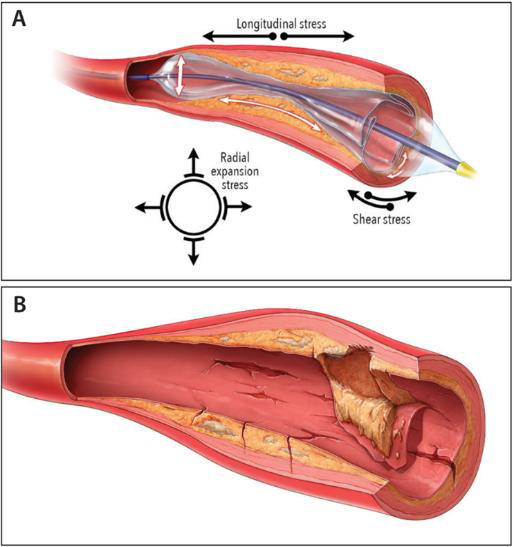
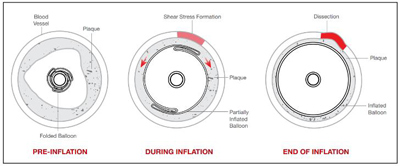 High shear stress
High shear stress
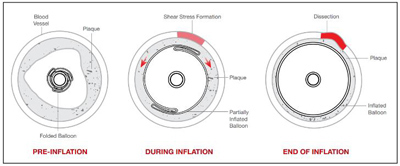
Uneven radial expansion force

Longitudinal stress (tensile)
Uncontrolled PTA balloon dilation acting on unevenly distributed plaques can easily lead to intimal tearing and elastic recoil, resulting in dissection.
Therefore, there is an urgent clinical need for new tools to achieve optimal vascular preparation.
The Design Journey of Kossel’s Tanghulu™ Tanghulu™PTA Balloon Dilatation Catheter
Reflection
Based on the goals of optimal vascular preparation, our initial design aimed to tackle two core challenges.
1、How to reduce dissections.
2、Achieve better lumen access.
Based on these two goals, we embarked on the journey of innovative design for the sugar-coated hawthorn balloon, aiming to provide better lumen preparation tools for clinical use.
At the beginning of the design process, three major issues needed to be overcomed!
Question 1: Balloon selection: semi-compliant? Non-compliant?
After considering clinical recommendations, design validation, and safety considerations, we ultimately chose a semi-compliant balloon. (Reflections on semi-compliant balloons) — Prioritizing low injury, followed by high dilation force.
Question 2: What to do about the formation of dissections?
POBA balloons are semi-compliant balloons, but after expansion, they are prone to the ‘dog-bone effect.
By analyzing the mechanical changes during POBA balloon expansion (high shear stress, excessive longitudinal stress, and uneven radial expansion force), we aim to solve three issues: reduce shear stress, minimize longitudinal stress, and balance radial expansion force.
Design Solutions
①Limit balloon diameter variation — reduce the dog-bone effect.
②Segmented short-length dilation — plaque remodeling and stress balancing.
Thus, based on the semi-compliant balloon, we added a self-expanding stent design to the balloon.
Nitinol self-shrink stent with segmented balloon design.
Cross-wire constraint, forming balloon bulge and relief grooves.
🔵Radial constraint to reduce balloon torsion amplitude — decrease shear stress.
🔵Longitudinal constraint to reduce balloon longitudinal extension — decrease longitudinal stress.
🔵Evenly distributed balloon bulge and relief grooves — balance the radial expansion force of the balloon.
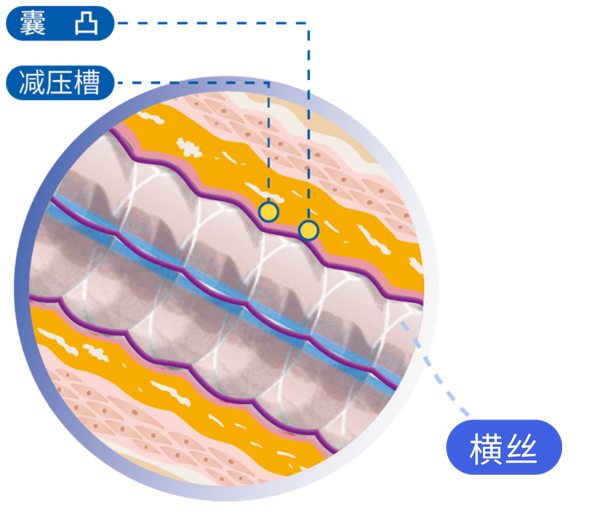
Finite element analysis: Uniform stress distribution in the balloon bulge.
Question 3: How to achieve lumen access?
The scored balloon inspired us!!!
Design solutions.
Localized scoring design to reduce contact area and increase dilation force.
Principle
Focused dilation force (P) = Balloon inflation pressure (F) / Balloon contact area (A).
When the balloon contact area decreases and the balloon inflation pressure remains constant, the focused dilation force increases.
Related research
Through the pressure focusing of an external guidewire, the localized pressure exerted is approximately 120 times greater than that of a traditional PTA balloon.
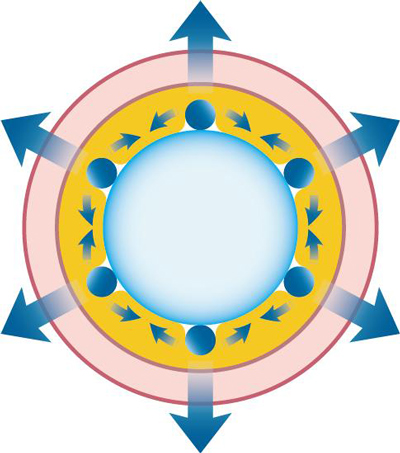
Longitudinal wire design of Tanghulu™ PTA Balloon Dilatation Catheter
- Longitudinal wire scoring, evenly distributed; low-pressure focusing, directional dilation.
- Longitudinal wires make initial contact with the lesion, achieving low-pressure focused dilation and optimal lumen access.
- Six longitudinal wires are evenly distributed for directional dilation.

Finite element analysis: The stress of the longitudinal wires on the vascular wall is clearly visible.
Design solutions
Overall constraint with localized scoring — reducing dissections while achieving excellent lumen access.
After several years of meticulous research and development, Kessel has finally achieved a revolutionary breakthrough — the brilliant launch of the sugar-coated hawthorn balloon, which combines reduced dissections with excellent lumen access, leading a new trend in vascular intervention.
References.
[1] Bao Junmin. New Advances and Evaluation of Endovascular Treatment Techniques for Lower Limb Arterial Occlusive Disease. Journal of Practical Surgery, 2018, 38(12): 1436-1439.
